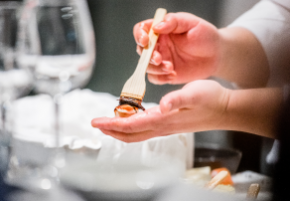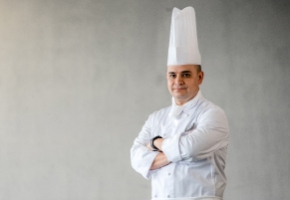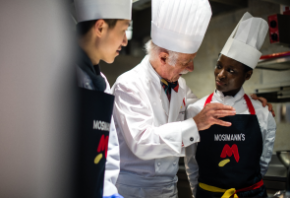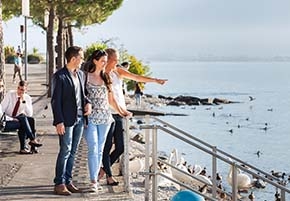- About
- Programs
- Campus Life
- Career Services
- Admissions
- News & Events
- Alumni
How to Set a Table: Simple Steps for Any Occasion
Learn how to set a table for casual dinners or formal events with easy-to-follow steps. Master table etiquette and learn to impress guests today!
Key Takeaways
- A well-set table helps create a warm, inviting atmosphere that makes every meal feel special.
- Attention to detail, like proper utensil placement and thoughtful centerpieces, is essential for a polished table look.
- Adapt your table setting to suit the occasion, whether casual, formal, or themed.
A beautifully set table will impress your guests and set the tone for the entire meal. Whether you're hosting a casual brunch or an elegant dinner, knowing how to set a table adds a thoughtful touch that shows you care.
Beyond forks and knives, setting a table is about creating a welcoming space where people feel comfortable and appreciated.
From simple everyday setups to more formal arrangements, learning how to set a table is easier than it seems. Let's break it down into practical steps you can use for any occasion.
Table Setting Essentials
Before you begin setting the table, it's useful to understand the key components of a well-styled setting. You don't need to go overboard; covering the basics is enough to make everything look polished without much effort.
Here are the essentials:
- Plates: A main plate for the entree, a smaller plate for salad, and a dessert plate if needed.
- Utensils: Forks, knives, and spoons, placed according to the courses you are serving.
- Glassware: Always include a water glass; add a wine glass if drinks are being served.
- Napkins and table linens: A simple cloth napkin and a clean tablecloth or placemat make a big difference.
- Optional extras: Chargers (decorative plates under the main plate), placemats, and centerpieces like candles or flowers for a bit of added charm.
How to Set a Table
Table settings can change depending on the occasion, from casual family dinners to formal events.
For casual meals
Casual meals are all about keeping things simple and practical without losing that nice, put-together look. You want your guests to feel comfortable and not concerned about remembering a set of rules. Setting a casual table does not take long, but it still makes the meal feel a little more special.
Here's a quick guide to setting a casual table:
- Plate: Set the dinner plate right in the center of the place setting.
- Cutlery: Place the fork on the left side of the plate. The knife goes to the right, with the blade facing the plate, and the spoon sits to the right of the knife.
- Glassware: Set a water glass slightly above the knife, toward the top right of the plate.
- Napkin: Either place the napkin neatly on top of the plate or fold it and set it to the left of the fork.
Simple and neat always does the trick.
For formal dinners
Formal dinners call for a bit more attention to detail, creating an experience that feels polished and elegant. Since formal meals usually involve multiple courses, the table needs to be set to guide guests through each one with ease. It might look complicated at first, but once you know the steps, it all falls into place.
Here's how to set a formal table:
- Plate: Start by placing a charger plate at each setting. Stack the appetizer or soup plate on top if the first course is already being served.
- Cutlery: Line up multiple forks on the left side, with the salad fork on the outside and the main course fork closer to the plate. On the right, place the knife (blade facing the plate) and a soup spoon if needed.
- Glassware: Arrange a water glass, white wine glass, and red wine glass in a triangle formation above the plate, with the water glass closest.
- Napkin: Fold the napkin creatively or slide it into a napkin ring for an extra touch of elegance.
It is all about layering pieces thoughtfully while keeping everything functional.
For special occasions
Special occasions are the perfect chance to get creative with your table setting and make it truly personal. Whether it is a wedding, holiday dinner, or a themed party, the table can reflect the spirit of the event and make the experience feel even more memorable. There are no strict rules here, just thoughtful choices that match the atmosphere you want to create.
Here's how to set a table for special occasions:
- Plates and cutlery: Start with the basics (plate and cutlery), then adjust depending on the meal. You might add extra utensils for unique courses or go for more elegant designs.
- Glassware: Include glasses that match the drink options being served, like champagne flutes for celebrations or cocktail glasses for a fun party.
- Decorative elements: Bring in special touches like name cards, themed centerpieces, candles, or seasonal flowers to tie everything together.
- Napkin presentation: Experiment with playful folds, colorful rings, or small decorative accents tucked into the napkin.
Special occasion tables blend personality with a welcoming, comfortable setting for your guests.
Why Proper Table Setting Matters
A properly set table creates an atmosphere of warmth and thoughtfulness that immediately makes guests feel welcome.
When everything is neatly arranged, it shows that thought and effort went into making the meal enjoyable. It transforms a simple gathering into a memorable experience, making the meal feel more organized and purposeful.
The small details, like neatly folded napkins or carefully placed cutlery, do more than just serve a functional role; they show that you value your guests' time and comfort.
When people feel cared for in these little ways, they are more likely to relax and fully enjoy the meal. Whether it's a casual dinner or a special occasion, a well-set table sets the tone for a delightful experience, making everyone feel special and appreciated.
Special Tips for Table Setting
For an elevated table setting, a few etiquette tips can make a big difference.
Creative centerpieces
Centerpieces are the heart of your table's visual appeal. They serve as a focal point, tying together the theme and creating an inviting atmosphere. Whether you prefer something simple or elegant, centerpieces offer the perfect opportunity to get creative and personalize the setting.
For a minimalist look, you can use small floral arrangements, candles, or a bowl of fruit. These ideas keep things fresh and light, focusing on natural beauty.
For a more elegant touch, consider tall floral arrangements, candelabras, or decorative vases that add height and sophistication to the table.
Themed centerpieces can also enhance the overall ambiance, like pumpkins for Thanksgiving, ornaments for Christmas, or seashells for a beach-themed dinner. Such elements help reinforce the event's spirit and create a cohesive, memorable look.
With the right centerpiece, your table becomes more than just a place to eat — it becomes a meaningful part of the celebration.
Linen and napkin folding ideas
For casual meals, choose simple cotton or linen tablecloths and runners in neutral or warm tones. These fabrics are practical, easy to clean, and give your table a relaxed, welcoming vibe. Neutral shades like beige, gray, or light brown work well with almost any setting, allowing your food and decor to take center stage.
For formal dinners, opt for more elegant fabrics like silk or embroidered tablecloths. Classic colors such as white, cream, or deep dark tones like navy or burgundy add sophistication and a polished feel to the table. These materials elevate the dining experience and complement the overall formality of the event.
Seasonal or theme-based linens can add a playful or festive touch to your table. For holidays, choose tablecloths or napkins with festive patterns like plaid for Thanksgiving or snowflakes for Christmas. Vibrant, bold hues work well for outdoor gatherings, especially during summer, where bright colors like teal or coral can create an inviting, cheerful atmosphere.
Matching your linens to the event or season enhances the overall mood and makes the occasion feel even more special.
Common Mistakes to Avoid
When setting a table, a few common mistakes can affect the overall look and feel of your meal. Here are some things to avoid:
- Incorrect utensil placement: Always remember to place utensils in the proper order, from the outermost (used first) to the innermost (used last). For example, the salad fork should be on the outside, with the main course fork closer to the plate. Misplacing utensils can confuse guests and disrupt the dining flow.
- Overcrowding the table: Too many items on the table can make it feel cramped and overwhelming. Keep the setting simple and only include what's necessary for the meal. Leave space for guests to comfortably move and enjoy their food.
- Blocking guest visibility: Avoid using tall centerpieces or decorations that block guests' sightlines across the table. While centerpieces are important, they should not obstruct conversation or the view of the rest of the table.
- Mismatched or clashing elements: A cohesive look is key to a well-set table. Avoid mixing too many styles, patterns, or colors that don't complement each other. Stick to a theme to ensure everything ties together smoothly.
- Improper napkin placement: Whether folded neatly on the plate or tucked in a napkin ring, make sure the napkin is placed thoughtfully. Poorly placed napkins can detract from the overall elegance of the table setting.
Mastering the Art of Table Setting
Setting a table is about creating an atmosphere that enhances the dining experience. From understanding the essentials of table settings to adding creative centerpieces, the right touches make a lasting impression. Avoiding common mistakes like incorrect utensil placement or overcrowding the table ensures a smooth, enjoyable meal for your guests.
The Culinary Arts BA program is an ideal starting point for those looking to sharpen their culinary skills and develop expertise in event planning. The curriculum covers everything from the fundamentals of elegant table setting and menu design to advanced culinary techniques like molecular gastronomy and presentation artistry—essential skills for creating memorable dining experiences at events.
Join CAAS today and start mastering the skills that bring every meal to life with our culinary degree!
Frequently Asked Questions (FAQs)
Should table settings differ for outdoor vs. indoor events?
Yes, table settings for outdoor events often include more casual, sturdy items, like melamine plates or plastic glassware, to handle the elements, while indoor events can feature finer china and glassware.
What is the correct way to pass food during a meal?
When passing food, always pass counterclockwise and offer the dish to the person on your left first. Never reach across others' plates.
Interested in studying at CAAS? Download our brochure to learn about our programs!
























